Have you been searching for answers involving How To Use Your Toilet Plunger Correctly in 5 Easy Steps?

Introduction
Proper maintenance of house drains pipes is vital for avoiding clogs and guaranteeing smooth water circulation. One of the key devices in every house owner's toolkit is the plunger, alongside numerous drain cleansers developed to deal with stubborn obstructions successfully. This article checks out just how to use plungers and drainpipe cleaners successfully to maintain your drains streaming easily.
Area 1: Recognizing Plungers
Types of Plungers
There are several kinds of bettors readily available, each developed for different kinds of drains pipes and obstructs. One of the most usual types include cup bettors, flange bettors, and accordion bettors.
Just How Plungers Job
Bettors service the principle of creating pressure and suction to dislodge obstructions. When properly applied over a drainpipe, they produce a vacuum cleaner that can take out debris or separate obstructions.
Selecting the Right Plunger
Picking the ideal plunger depends on the type of drainpipe and the nature of the clog. Mug plungers are perfect for sinks and bathtubs, while flange plungers are much better suited for commodes due to their layout.
Common Errors with Bettors
Preventing these blunders ensures reliable plunging: inappropriate seal around the drainpipe, inadequate force, and not clearing surrounding debris.
Area 2: Utilizing Plungers Successfully
Preparation
Before plunging, make sure the bettor covers the drainpipe completely and forms a tight seal. Clear any type of noticeable particles around the drainpipe opening.
Technique
Start with gentle plunging movements to develop suction. Boost pressure slowly, utilizing a constant rhythm. Repeat as essential till the drain removes.
Fixing Tips
If plunging doesn't function, try changing the seal, applying petroleum jelly for a better seal, or making use of a various type of bettor.
Section 3: Understanding Drainpipe Cleaners
Sorts Of Drain Cleaners
Drain pipes cleaners can be chemical or enzymatic. Chemical cleansers use strong chemicals to liquify blockages, while chemical cleaners use natural enzymes to break down raw material.
Exactly How Drain Cleaning Company Work
Chemical cleansers respond with obstructions to dissolve them, while enzymatic cleansers break down organic products like hair and oil without harming pipelines.
Safety Considerations
Constantly wear gloves and eye defense when utilizing chemical drain cleansers. Guarantee ample air flow and follow maker guidelines carefully.
Eco-Friendly Alternatives
Think about utilizing vinegar and cooking soft drink or enzyme-based cleaners for environmentally friendly choices that are much safer for pipes and the environment.
Section 4: Making Use Of Drain Cleaners Effectively
Application Strategies
Put chemical cleansers directly into the drainpipe opening. Enable them to help the recommended time before purging with hot water. Chemical cleaners should rest overnight.
Safety measures
Avoid mixing different types of cleansers, as this can generate harmful fumes. Never ever use chemical cleansers together with a plunger, as spilling can take place.
Handling Stubborn Obstructions
For consistent obstructions, think about making use of a plumbing serpent or calling a specialist plumber to avoid damages to pipes.
Final thought
Finally, understanding exactly how to utilize bettors and drainpipe cleansers properly is essential for maintaining healthy and balanced pipes systems. By choosing the right devices and strategies, homeowners can tackle minor clogs and prevent significant plumbing issues down the line.
How to Use a Plunger to Unclog a Drain
The humble plunger is a simple yet effective tool for breaking clogs in sinks, tubs and toilets. This handy tool is easy to use. You can make the most of its power if you understand how it works. Ready to dive in? Here’s what you need to know.
Safety First!
Never use a plunger with drain chemicals. Water will splash as you work, and the chemicals can spatter, burning skin and eyes. It’s a good idea to use rubber gloves and wear safety goggles when you work on a clog.
Choose the Right Tool for the Job
Plungers come in two different styles. Sinks, bathtubs and showers require a cup plunger. Like its name suggests, the rubber end is shaped like a cup. Use a flange plunger on toilets. These plungers have a rubber funnel extending from the cup. A plunger needs to be big enough to cover the drain.
Ready, Set, Plunge!
Coat the rim: Coat the plunger rim with petroleum jelly. This helps make a better seal.
Block outlets: Hold a wet rag over nearby outlets such as the overflow vent or the drain in a second sink.
Release air: Insert the plunger at an angle into the water. Water will displace air in the cup. A water-filled cup is more forceful than one filled with air.
Keep the plunger upright: Hold the plunger perpendicular to the drain. Use fast, forceful strokes, but make the first stroke gentle. The first stroke can create a splash if the cup still contains air. Thrust the plunger 15 to 20 times.
Snap off the plunger: The final stroke should be a strong upward motion that ends when the plunger snaps off the drain.
Repeat the process: you may need to repeat this sequence several times. When the water drains away, your work is done. High-five! https://plumbernw.com/blog/how-to-use-a-plunger-to-unclog-a-drain/

Application Strategies
Put chemical cleansers directly into the drainpipe opening. Enable them to help the recommended time before purging with hot water. Chemical cleaners should rest overnight.
Safety measures
Avoid mixing different types of cleansers, as this can generate harmful fumes. Never ever use chemical cleansers together with a plunger, as spilling can take place.
Handling Stubborn Obstructions
For consistent obstructions, think about making use of a plumbing serpent or calling a specialist plumber to avoid damages to pipes.
Final thought
Finally, understanding exactly how to utilize bettors and drainpipe cleansers properly is essential for maintaining healthy and balanced pipes systems. By choosing the right devices and strategies, homeowners can tackle minor clogs and prevent significant plumbing issues down the line.
How to Use a Plunger to Unclog a Drain
The humble plunger is a simple yet effective tool for breaking clogs in sinks, tubs and toilets. This handy tool is easy to use. You can make the most of its power if you understand how it works. Ready to dive in? Here’s what you need to know.
Safety First!
Never use a plunger with drain chemicals. Water will splash as you work, and the chemicals can spatter, burning skin and eyes. It’s a good idea to use rubber gloves and wear safety goggles when you work on a clog.
Choose the Right Tool for the Job
Plungers come in two different styles. Sinks, bathtubs and showers require a cup plunger. Like its name suggests, the rubber end is shaped like a cup. Use a flange plunger on toilets. These plungers have a rubber funnel extending from the cup. A plunger needs to be big enough to cover the drain.
Ready, Set, Plunge!
Coat the rim: Coat the plunger rim with petroleum jelly. This helps make a better seal. Block outlets: Hold a wet rag over nearby outlets such as the overflow vent or the drain in a second sink. Release air: Insert the plunger at an angle into the water. Water will displace air in the cup. A water-filled cup is more forceful than one filled with air. Keep the plunger upright: Hold the plunger perpendicular to the drain. Use fast, forceful strokes, but make the first stroke gentle. The first stroke can create a splash if the cup still contains air. Thrust the plunger 15 to 20 times. Snap off the plunger: The final stroke should be a strong upward motion that ends when the plunger snaps off the drain. Repeat the process: you may need to repeat this sequence several times. When the water drains away, your work is done. High-five! https://plumbernw.com/blog/how-to-use-a-plunger-to-unclog-a-drain/

Do you really like reading about How to Unclog Your Sink with a Plunger? Create feedback below. We would be pleased to see your insights about this entry. In hopes that you visit us again soon. Are you aware of somebody who is serious about the subject? Feel free to promote it. Bless you for your time. Return soon.
Book